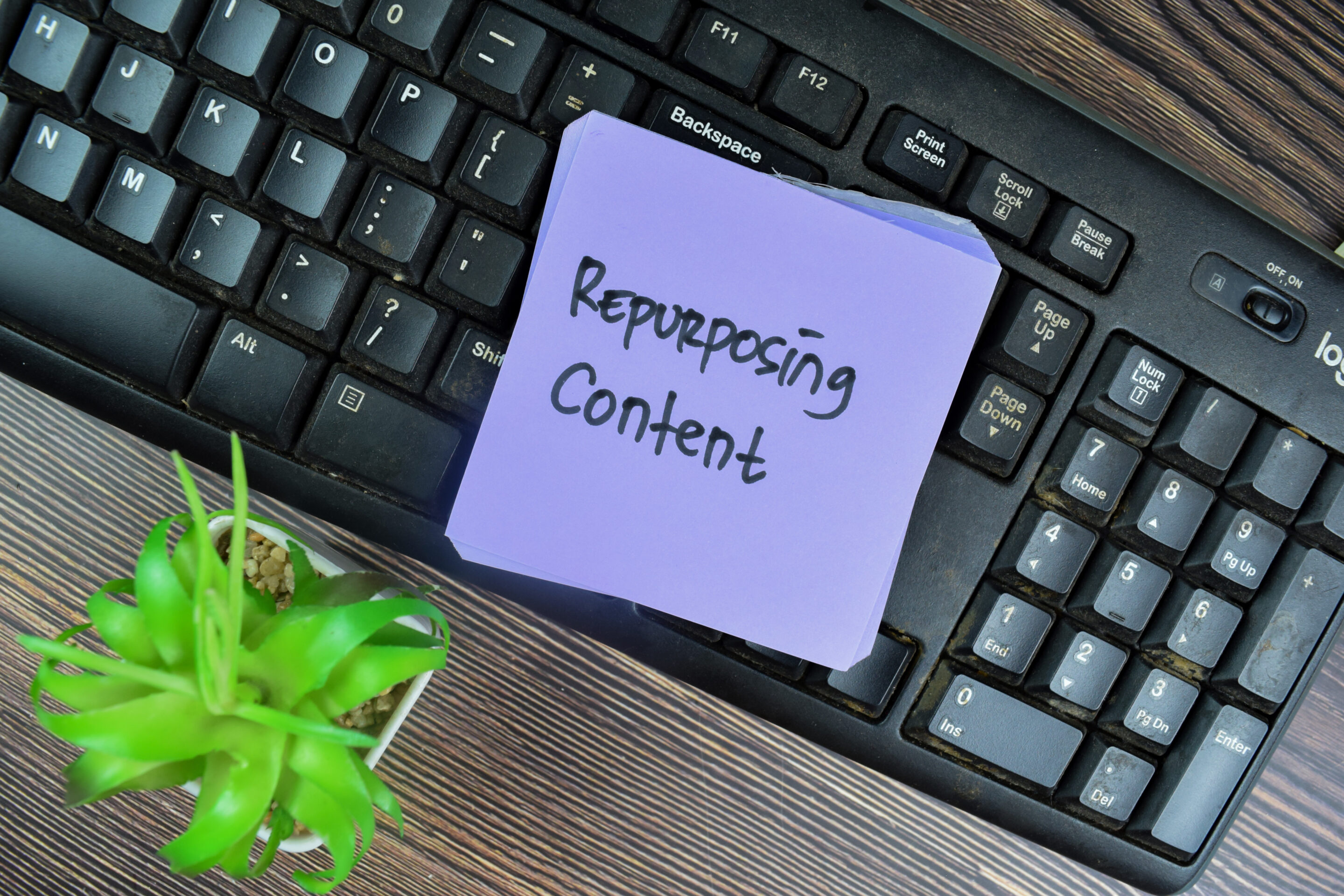“You’re not being repetitive, you’re using content you and your teams have purposely created, giving it new life, and ensuring that all segments of your audience can gain value from what you have to offer.” – Flori Needle.
Creating fresh marketing content that consistently engages your audience requires time, energy and money.
With content demand constantly on the rise and organic reach declining, it’s important to maximize the value of the content you’ve already invested time and effort into producing. This is where content repurposing comes into play.
This article explores why content repurposing is critical to promoting your brand, and provides a step-by-step guide on how to implement it in your marketing strategy.
What is Content Repurposing?
Content repurposing (aka, content recycling) is the practice of adapting existing content to different formats or platforms. The purpose is to cost-effectively increase your content production and reach a wider and more diverse audience.
Repurposing Content Vs. Reusing or Reposting Content
Content repurposing involves adapting content to make it fresh and appealing in different formats or for new audiences, whereas reusing or reposting content involves sharing the same content without substantial alterations.
Each strategy has a place in content marketing, depending on business objectives and the audience you intend to engage.
Why Content Repurposing Matters
Content repurposing matters in today’s digital marketing landscape:
Extended Reach
Repurposing content allows you to breathe new life into your existing material, effectively extending its reach. When businesses presenting the same information in new formats or on different platforms, they can reach a more diverse audience.
Cost-Efficiency
Repurposing content is budget-friendly compared to creating entirely new content from scratch. It makes your initial investment in content creation go further and provides more value for your marketing budget.
Brand Awareness
When you repurpose content across multiple channels, you increase your brand’s visibility. Your audience encounters your brand in different contexts, reinforcing brand recognition.
Efficiency and Speed
Repurposing is a quicker process than creating entirely new content. It’s particularly useful when you have limited time or resources. You can maximize your output without sacrificing quality.
Diverse Audience Appeal
Diverse audiences prefer consuming content in different formats—some like visuals, some prefer text, and others enjoy videos or podcasts. Repurposing ensures you cater to these preferences, expanding your audience base.
Adaptation to Platform Changes
As new platforms emerge and algorithms evolve, repurposing content helps marketers adapt quickly to changing circumstances. Content managers can modify materials to suit the requirements of new platforms without starting from scratch.
“The number #1 benefit of repurposing content is that it makes content MUCH easier to scale. In other words: you don’t need to write every post, shoot every video and design every infographic from scratch. Instead, you can use a piece of new content as the basis for posts, videos, social media posts, webinars and more.” – Brian Dean.
Evergreen Content, What’s that?
Marketers focus almost 100% of their repurposing efforts on Evergreen Content.
Evergreen content remains relevant and valuable to readers or viewers over an extended period. It doesn’t become quickly outdated or tied to a specific time or event.
Evergreen content continues to provide value and attract an audience long after its initial publication.
How to Master Content Repurposing: Step-by-Step Guide
Mastering content repurposing involves a systematic approach to transform your existing content into fresh, engaging material. Here’s a step-by-step guide to help you get started:
Step 1: Content Assessment and Selection
Begin by assessing your existing content library. Identify pieces that have performed well in terms of engagement or those with valuable information. These will be your primary candidates for repurposing.
Step 2: Define Your Goals
Before repurposing, establish clear objectives for each piece of content. Are you aiming to reach a different audience, improve engagement, or boost your brand’s authority? Knowing your goals will guide the repurposing process.
Step 3: Choose Repurposing Formats
Determine the new formats or platforms you want to target with your repurposed content. Common formats include:
- Videos
- Infographics
- Slide presentations
- Podcasts
- Webinars
- Social media posts
- Blog posts
- eBooks
Select formats that align with your goals and audience preferences.
Step 4: Adapt and Optimize Content
Now, it’s time to adapt your content to fit the chosen formats. For example:
- Convert a blog post into a video script.
- Transform a webinar into a series of blog posts.
- Create visually appealing infographics summarizing key points from an article.
- Extract insightful quotes from a podcast for social media posts.
Ensure each repurposed piece maintains the essence and value of the original content while catering to the characteristics of the chosen format.
Step 5: Create a Repurposing Schedule
Develop a content repurposing schedule to manage your efforts efficiently. Determine when and where you’ll publish each repurposed piece to maximize its impact. Consistency is key to maintaining audience engagement.
Step 6: Optimize SEO and Keywords
Remember to optimize your repurposed content for search engines. Identify relevant keywords and incorporate them naturally into your content to improve discoverability and drive organic traffic.
Step 7: Promote Across Channels
Promote your repurposed content across various channels to reach a wider audience. Share it on your social media platforms, email newsletters, and any relevant communities or forums. Encourage sharing and engagement.
Step 8: Analyze and Iterate
Track the performance of your repurposed content. Analyze metrics such as engagement, traffic, and conversion rates. Use this data to refine your repurposing strategy for future content.
Step 9: Stay Updated
Stay informed about the latest trends and changes in your industry and the digital marketing landscape. Adapt your repurposing strategy accordingly to remain relevant and effective.
“Repurposing content is a powerful strategy that can save time and resources, reach new audiences, and reinforce your brand message. Before you rush to create new content, take a moment to consider the gold mine of content you already have.” – Kobi Ben-Meir.
Conclusion
Content repurposing is a marketing strategy that allows businesses to get the most out of existing content and improve its reach.
When businesses extend content reach, they can cater to diverse audience preferences, and enhance brand visibility while remaining cost-effective.
Implement the step-by-step guide provided in this article to master the art of content repurposing and take your digital marketing efforts to the next level.
Thank you for reading our article!
TimeWellScheduled is a secure online time and attendance software 100% tailored to meet your scheduling needs! In Addition, our cloud-based scheduling solution optimizes employee attendance tracking, simplifies payroll administration, and enhances staff management capabilities. Plus, our service is free for up to 10 employees!
Click here to download our (Excel) employee scheduling template; It’s FREE!






